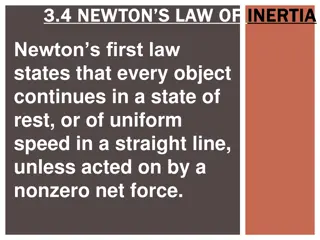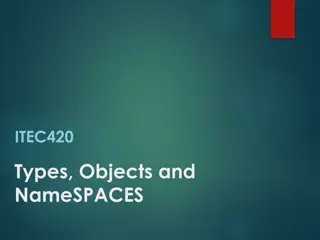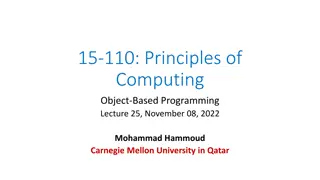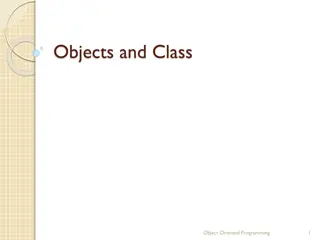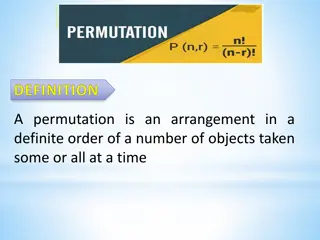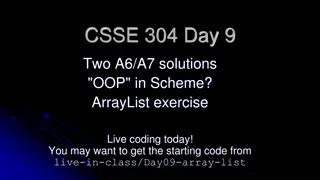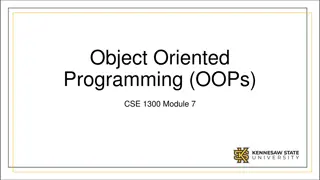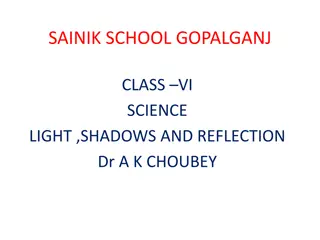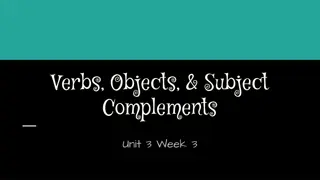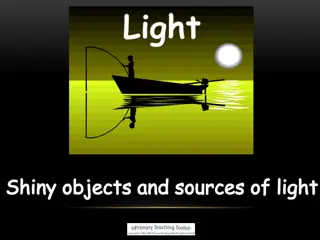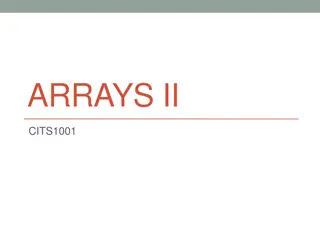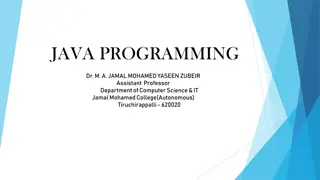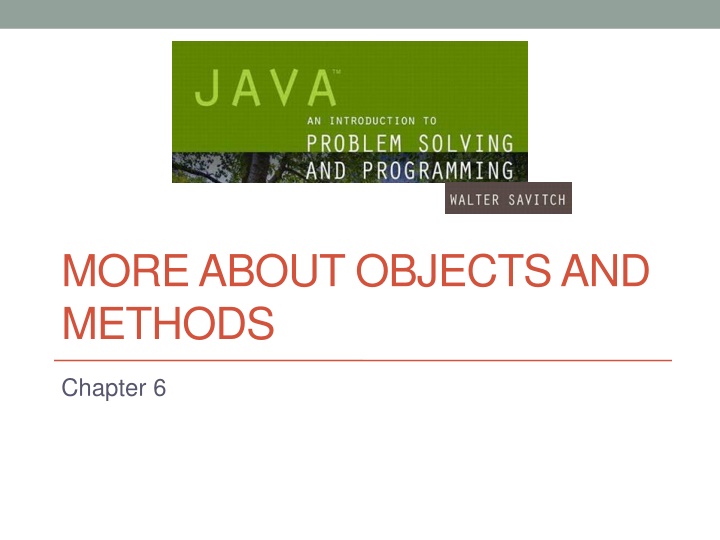
Constructors and Methods in Java Programming
Explore constructors, static variables, overloaded methods, and more in Java programming. Learn how to define constructors, call methods from constructors, and work with different types of constructors to initialize objects effectively.
Download Presentation

Please find below an Image/Link to download the presentation.
The content on the website is provided AS IS for your information and personal use only. It may not be sold, licensed, or shared on other websites without obtaining consent from the author. If you encounter any issues during the download, it is possible that the publisher has removed the file from their server.
You are allowed to download the files provided on this website for personal or commercial use, subject to the condition that they are used lawfully. All files are the property of their respective owners.
The content on the website is provided AS IS for your information and personal use only. It may not be sold, licensed, or shared on other websites without obtaining consent from the author.
E N D
Presentation Transcript
MORE ABOUT OBJECTS AND METHODS Chapter 6
2 CSC111 Adapted from: "JAVA: An Introduction to Problem Solving & Programming", 8th Ed. Objectives Define and use constructors Write and use static variables and methods Write and use overloaded methods
3 CSC111 Adapted from: "JAVA: An Introduction to Problem Solving & Programming", 8th Ed. CONSTRUCTORS Ch 6.1
4 CSC111 Adapted from: "JAVA: An Introduction to Problem Solving & Programming", 8th Ed. Constructors: Outline Defining Constructors Calling Methods from Constructors Calling a Constructor from Other Constructors
5 CSC111 Adapted from: "JAVA: An Introduction to Problem Solving & Programming", 8th Ed. Defining Constructors A constructor is a special method called automatically when an instance of an object is created with new ClassName x = new ClassName(); has the same name as the class name. can have parameters to specify initial values if desired but cannot return values and it is not a void method May have multiple definitions Each with different numbers or types of parameters A class contains at least one constructor.
6 CSC111 Adapted from: "JAVA: An Introduction to Problem Solving & Programming", 8th Ed. Defining Constructors Example class to represent pets Figure 6.1 Class Diagram for Class Pet
7 CSC111 Adapted from: "JAVA: An Introduction to Problem Solving & Programming", 8th Ed. Defining Constructors Note sample code, listing 6.1 class Pet Note different constructors Default With 3 parameters With String parameter With double parameter Note sample program, listing 6.2 class PetDemo
8 CSC111 Adapted from: "JAVA: An Introduction to Problem Solving & Programming", 8th Ed. Defining Constructors Sample screen output
9 CSC111 Adapted from: "JAVA: An Introduction to Problem Solving & Programming", 8th Ed. Default Constructors A constructor without parameters is a default constructor Java will define this automatically, but ONLY if the class designer does not define any constructors If you do define a constructor, Java will not define a default constructor automatically, but you can still add one Usually default constructors are not included in class diagrams (UML)
10 CSC111 Adapted from: "JAVA: An Introduction to Problem Solving & Programming", 8th Ed. Pet fish = new Pet("Wanda", 2, 0.25);
11 CSC111 Adapted from: "JAVA: An Introduction to Problem Solving & Programming", 8th Ed. Calling Methods from Other Constructors Constructor can call other class methods View sample code, listing 6.3 class Pet2 Note method set Keeps from repeating code
12 CSC111 Adapted from: "JAVA: An Introduction to Problem Solving & Programming", 8th Ed. Example: Constructor with No-Parameter A. The instance variable is allocated in memory. P1 public class Person { String name; int age; // Constructor public Person(){ name = ; age = 0;} } name B. The object is created with initial state Person age 0 C. The reference of the object created in B is assigned to the variable. P1 A B Person P1; name Person P1 = ; new Person( ) 0 age C Code State of Memory
13 CSC111 Adapted from: "JAVA: An Introduction to Problem Solving & Programming", 8th Ed. Example: Class with Multiple Constructors A. The constructor declared with no-parameter is used to create the object Public class Person { String name; int age; // Constructor public Person(){ name = ; age = 0;} public Person(String n, int a ) { name = n; age = a; }} P1 name Person age 0 B. The constructor declared with parameters is used to create the object P2 A name Person P1 , P2; Ahmad Person B age 27 P1 = new Person() P2 = new Person( Ahmed ,27); State of Memory Code
15 CSC111 Adapted from: "JAVA: An Introduction to Problem Solving & Programming", 8th Ed. STATIC VARIABLES AND METHODS Ch 6.2
16 CSC111 Adapted from: "JAVA: An Introduction to Problem Solving & Programming", 8th Ed. Static Variables & Methods: Outline Static Variables Static Methods Dividing the Task of a main Method into Subtasks Adding a main Method to a class (optional) Predefined methods Wrapper Classes (optional)
17 CSC111 Adapted from: "JAVA: An Introduction to Problem Solving & Programming", 8th Ed. Static Variables They are variables declared as static They are shared by all objects of a class Only one instance of the variable exists It can be accessed by all instances of the class via the class name or the object name Static variables are also called class variables Contrast with instance variables Note: Do not confuse class variables with variables of a class type Both static (class) variables and instance variables are sometimes called fields or data members or attributes Underline static variables in UML diagram
18 CSC111 Adapted from: "JAVA: An Introduction to Problem Solving & Programming", 8th Ed. Static Variables Values of variables declared: static final cannot be changed, they are constants static (without final) can be changed A common examples of static attributes is to have a variable that keeps track of how many objects of a class have been created.
19 CSC111 Adapted from: "JAVA: An Introduction to Problem Solving & Programming", 8th Ed. Constructor and Static attribute public class Person { ... public static void main(String[] args) { System.out.println (Person.numofPerson); String name; int age; public static int numofPerson=0; // Constructor public Person() { name = ; age = 0; numofPerson++; } public Person(String n , int a) { name = n; age = a; numofPerson++; } Person P1 = new Person(); Person P2 = new Person( ahmed , 27); System.out.println (Person.numofPerson); } ... } // end class Person
20 CSC111 Adapted from: "JAVA: An Introduction to Problem Solving & Programming", 8th Ed. Constructor and Static attribute public static void main(string[] args) { Person P1 = new Person(); Person P2 = new Person ( ahmed , 27); } P1 name Person 0 numofPerson age A B 0 1 2 P2 Person Ahmed A name age Person P1 , P2; 27 B P1 = new Person() P2 = new Person( Ahmed ,27); Code State of Memory
21 CSC111 Adapted from: "JAVA: An Introduction to Problem Solving & Programming", 8th Ed. Course +studentName: String +courseCode: String +studentNumber:int class Course { // attributes public String studentName; // Instance variables public String courseCode ; // Instance variables public static int studentNumber; // Class variables } public class CourseRegistration { public static void main(String[] args) { Course course1, course2; //Create and assign values to course1 course1 = new Course( ); Course.studentNumber = 1; course1.courseCode= CSC112 ; course1.studentName= Majed AlKebir ; //Create and assign values to course2 course2 = new Course( ); Course.studentNumber ++; course2.courseCode= CSC107 ; course2.studentName= Fahd AlAmri ; System.out.println(course1.studentName + " has the course + course1.courseCode + + course1.studentNumber); System.out.println(course2.studentName + " has the course + course2.courseCode + + course2.studentNumber); } } CourseRegistration +main()
22 CSC111 Adapted from: "JAVA: An Introduction to Problem Solving & Programming", 8th Ed. Class Attributes and instance Attributes course1 Object: Course Majed AlKebir studentName courseCode course2 CSC112 Object: Course studentNumber 2 studentName Fahd AlAmri courseCode CSC107
CSC111 Adapted from: "JAVA: An Introduction to Problem Solving & Programming", 8th Ed. 23 ACTIVITY: CLASS EXAMPLE
24 CSC111 Adapted from: "JAVA: An Introduction to Problem Solving & Programming", 8th Ed. Example - Account Class Create a Java class based on the following UML : Account - number :int - balance : double +deposit (double amount) : void +withdraw(double amount) : void The class should: Have a default constructor that initializes the attributes to default values, and another constructor that initializes the data attributes to given values. Method deposit will add to balance Method withdraw will reduce the balance Provide set() and get() methods for each attribute. In the main() method of the class TestAccount write statements that will call both constructors and test class Accounts capabilities.
25 CSC111 Adapted from: "JAVA: An Introduction to Problem Solving & Programming", 8th Ed. Class Account public class Account { // definition of attributes (data) private int number; private double balance; // constructor public Account () { number=0; balance=0; } public Account (int n , double b) { number=n; balance=b; } // definition of operations public void deposit (double amount) { balance = balance + amount; } //end of deposit public void withdraw(double amount) { if (balance >= amount) balance = balance amount; } //end of withdraw public void setNumber (int n) { number = n; } //end of setNumber public void setBalance (double b) { balance=b; } //end of setBalance public int getNumber() { return number ; } //end of getNumber public double getBalance() { return balance; } //end of getBalance } //end of class
26 CSC111 Adapted from: "JAVA: An Introduction to Problem Solving & Programming", 8th Ed. Class TestAccount public class TestAccount { public static void main(String[] args) { Account Account1=new Account(); Account Account2=new Account(1,6200); Account1. setNumber (2) ; Account1. setBalance (4300) ; Account2. deposit (550) ; Account1. withdraw(200); System.out.println(Account1. getBalance() + "-" +Account2. getBalance() ); } }
27 CSC111 Adapted from: "JAVA: An Introduction to Problem Solving & Programming", 8th Ed. Static Methods Some methods may have no relation to any type of object Example Compute max of two integers Convert character from upper- to lower case Static methods declared in a class Can be invoked without using an object Instead use the class name For example, Math library functions.
28 CSC111 Adapted from: "JAVA: An Introduction to Problem Solving & Programming", 8th Ed. Static Methods Sample screen output
30 CSC111 Adapted from: "JAVA: An Introduction to Problem Solving & Programming", 8th Ed. Mixing Static and Nonstatic Methods
31 CSC111 Adapted from: "JAVA: An Introduction to Problem Solving & Programming", 8th Ed. Mixing Static and Nonstatic Methods
32 CSC111 Adapted from: "JAVA: An Introduction to Problem Solving & Programming", 8th Ed. Mixing Static and Nonstatic Methods
33 CSC111 Adapted from: "JAVA: An Introduction to Problem Solving & Programming", 8th Ed. Tasks of main in Subtasks Program may have Complicated logic Repetitive code Create static methods to accomplish subtasks Consider example code, listing 6.9 a main method with repetitive code Note alternative code, listing 6.10 uses helping methods
34 CSC111 Adapted from: "JAVA: An Introduction to Problem Solving & Programming", 8th Ed. Tasks of main in Subtasks
35 CSC111 Adapted from: "JAVA: An Introduction to Problem Solving & Programming", 8th Ed. Tasks of main in Subtasks
36 CSC111 Adapted from: "JAVA: An Introduction to Problem Solving & Programming", 8th Ed. Identifier Scope Example See Identifier scope outside example slides
37 CSC111 Adapted from: "JAVA: An Introduction to Problem Solving & Programming", 8th Ed. Pre-defined Methods See Pre-defined method slides.
46 CSC111 Adapted from: "JAVA: An Introduction to Problem Solving & Programming", 8th Ed. WRITING METHODS Ch 6.3
47 CSC111 Adapted from: "JAVA: An Introduction to Problem Solving & Programming", 8th Ed. Writing Methods: Outline Case Study: Formatting Output Decomposition Addressing Compiler Concerns Testing Methods
48 CSC111 Adapted from: "JAVA: An Introduction to Problem Solving & Programming", 8th Ed. Decomposition Recall pseudocode from listing 6.10 With this pseudocode we decompose the task into subtasks Then solve each subtask Combine code of subtasks Place in a method
49 CSC111 Adapted from: "JAVA: An Introduction to Problem Solving & Programming", 8th Ed. Addressing Compiler Concerns Compiler ensures necessary tasks are done Initialize variables Include return statement Rule of thumb: believe the compiler Change the code as requested by compiler It is most likely correct
50 CSC111 Adapted from: "JAVA: An Introduction to Problem Solving & Programming", 8th Ed. Testing Methods To test a method use a driver program Example code in listing 6.13 Every method in a class should be tested Bottom-up testing Test code at end of sequence of method calls first Use a stub simplified version of a method for testing purposes

